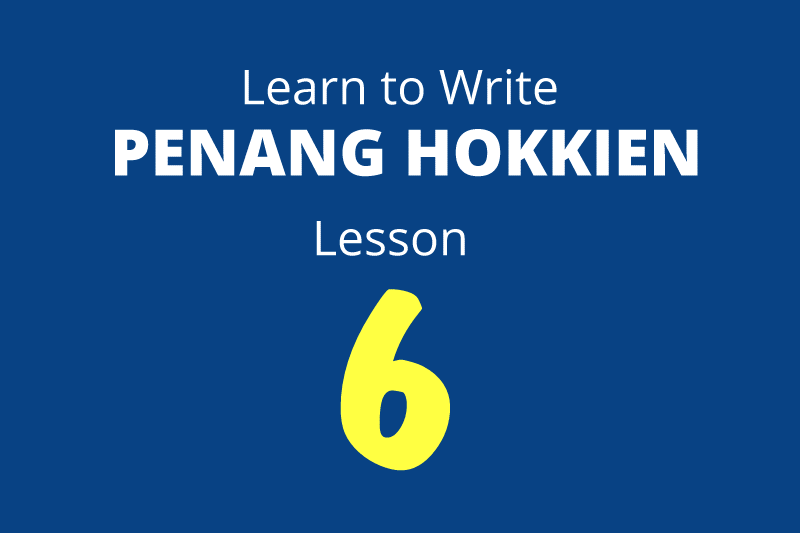

Now that we have gotten the ground rules in place, it's time for us to learn words in Penang Hokkien. You will see that I'm going at one baby step at a time, so that you have a chance to fully get to know the words I introduce in each lesson. Of course you have also learned a few words in the earlier lessons. You have also learned a few terms that I will use regularly, such as "citation form" (the form of a word that you get from the dictionary), "sandhi form" (the form of a word after it undergoes a tone change), and "morpheme" (the basic grammatical unit, which can be as short as one syllable, and carries a meaning). We also learn the "canonical form" (the main form when a word has several variants) and the "alternative form" (optional ways to write/pronounce the same word). Today we learn the personal pronouns "I" and "you".
"I" in Penang Hokkien is wah4
 . Please learn the spelling along with the tone number. This is a canonical form.
. Please learn the spelling along with the tone number. This is a canonical form.Some of us in Penang also pronounce it as gua4
 , so it's good to know the alternative form as well. I read in Wikipedia that the Penang wah4 bears Teochew influence. All right.
, so it's good to know the alternative form as well. I read in Wikipedia that the Penang wah4 bears Teochew influence. All right."You" in Penang Hokkien is lu4
 . There is no other variant that I can think of. Except perhaps, I should point out that it is different from "you" pronounced in the southern part of Peninsula Malaysia. There, they say li4. If you want to be recognised as speaking Penang Hokkien, then learn lu4.
. There is no other variant that I can think of. Except perhaps, I should point out that it is different from "you" pronounced in the southern part of Peninsula Malaysia. There, they say li4. If you want to be recognised as speaking Penang Hokkien, then learn lu4.Now let's put these two into a simple sentence.
I call you.
Wah1 kio33 lu4.

Notice here that "wah4" (citation form) has changed to "wah1" (sandhi form). It's the same if you invert the sentence.
You call me.
Lu1 kio33 wah4.

As you can see, "lu4" (citation form) also changes to "lu1" (sandhi form). You use the citation form when wah4 and lu4 appears as the object, you use the sandhi form when they appear as the subject. The good news is that pronouns in Hokkien don't undergo conjugation (there's no change in spelling, from "I" to "me", it's always wah, wah, wah, only the tone number changes).
Sentences where "wah4" and "lu4" are in the sandhi form are "regular sentences". In Penang Hokkien, you can emphasize specific words in a sentence, and wah4, lu4 are among them. To emphasize means to stress; you do so in English by underlining when you write or type, and in print, it appears as italics. But in Penang Hokkien, you don't need to underline or italicize. You emphasize by changing the tone back to the citation form. Like this:
I call you.
Wah4 kio33 lu4.

In the above example, the subject pronoun wah4 is emphasized, so it reverts to the citation form. The sentence means "I (not Jack, not Mary) call you".
The emphatic form of the subject pronouns wah4 and lu4 appear in colloquial speech more often than would the corresponding in English. When you listen to people speaking Penang Hokkien, you will notice that the speaker often ding-dong between wah1 and wah4 when used as subject, but he will always use wah4 for object. (Similarly, it's gua4 and gua1, if he uses that variant.)
So that covers our lesson for today. In our next lesson, we learn to use "he", "she" and "it".
Previous Lesson | Main Page | Next Lesson
Language Learning Tools
Use the following language learning tools to learn Penang Hokkien!Learn Penang Hokkien with uTalk
This app opens the door to over 150 languages.Return to Penang Hokkien Resources
About this website

Dear visitor, thank you so much for reading this page. My name is Timothy Tye and my hobby is to find out about places, write about them and share the information with you on this website. I have been writing this site since 5 January 2003. Originally (from 2003 until 2009, the site was called AsiaExplorers. I changed the name to Penang Travel Tips in 2009, even though I describe more than just Penang but everywhere I go (I often need to tell people that "Penang Travel Tips" is not just information about Penang, but information written in Penang), especially places in Malaysia and Singapore, and in all the years since 2003, I have described over 20,000 places.
While I try my best to provide you information as accurate as I can get it to be, I do apologize for any errors and for outdated information which I am unaware. Nevertheless, I hope that what I have described here will be useful to you.
To get to know me better, do follow me on Facebook!
Copyright © 2003-2025 Timothy Tye. All Rights Reserved.

 Go Back
Go Back
